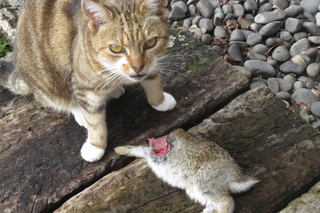by Laurie Collins
Editor’s note: Laurie Collins is now retired but still active recreationally in the “bush” particularly in the West Coast and Lewis Pass areas. His working career dealing with wildlife embraced early trials of 1080 poison, field work with the Forest Service and wildlife work in Marlborough, Fiordland and the Southern Alps.

Laurie Collins – working career with wildlife
The Department of Conservation plans to trial a new toxic meat bait for reducing feral cat numbers in the St James Conservation Area in 2024 so goes a recent report.
“Feral cats are a significant threat to New Zealand native biodiversity and the Department of Conservation has been developing this toxic meat bait for feral cats for several years. The baits containing sodium fluoroacetate (1080) will be aerially applied by helicopter within the Edwards Valley.”
At first glance some people might nod in agreement. Why even TV “celebrities” like Paddy Gower hate cats with a vengeance and tell the public so.
Gower, it seems, believes the spin and hype by the Department of Conservation. So too do many regional councils and campaigns like Predator Free NZ 2050 that say wild cats kill up to 100 million birds a year.
Really?
How was that figure arrived at? After all the Department of Conservation was grossly in error when it guessed at the national possum population to be 70 million. A Landcare Research scientist disparagingly told the department 1994 workshop it’s 70 million figure was a “back of cigarette packet calculation.” DoC ignored the scientist’s advice.
For years, its 70 million possum population figure was bandied about to bolster it anti-wild animal policies but constant challenging of the guessed figure, eventually forced DoC to revising it to another guess of 35 million.
So how scientific and accurate is that 100 million figure of birds killed by cats?
In fact there’s every reason to suspect it’s just another “back of cigarette packet calculation.”
Besides are wild cats the problem? Who or what is the problem?
Here’s a few pertinent comments:-
Craig Gillies in the Journal of the Royal Society of New Zealand 2001 – “In 10 Mainland studies of cat diet done since 1988, small mammals (mostly rabbits) and or mice were the most frequently occurring prey items.”
Another study of cat diet showed “in Hawkes Bay farmland, rats contributed relatively more than mice. Yet another said “in Northland rats were particularly frequent in the guts of cats caught in large tracts of kauri-podocarps forest.”
Even DoC studies point to rats being a major prey of cats.
Grant Harper Feral Cats on Stewart Island DoC Science Internal Series – “Cat numbers were limited by the seasonal availability of rats, their primary prey, which contributed 81 percent of cats’ diet by weight.
On Raoul Island a study showed rats are the main food of cats. Then the study warned while “eradicating cats from Raoul Island is feasible —-it is likely that eradicating cats without also eradicating Norway rats will do little to restore the diversity of bird species on Raoul Island.”
“Cats can help us manage the rodent population “ in that rats in many areas are the main prey for felines.
“Feral cats are often a secondary focus for pest control, and their impacts within an ecosystem are not well understood.”
Australia’s sub-Antartica Macquarie Island is another example. Decades of conservation effort was compromised on Macquarie Island when a feral cat eradication program from 1985 to 2000 led to unintended and unplanned consequences.
Terrestrial ecologist Dr Dana Bergstrom said that the programme, while well-intentioned, resulted in widespread ecosystem devastation when cats were eradicated and rabbit numbers exploded. Rabbits with no predators, dramatically increased and devastated the vegetation, resulting in top soil at the mercy of winds and rain.

Domestic cat with a young rabbit
Clearly DOC does not understand the simple conclusion that by removing wild cats will result in more rats.
While wild cats have a litter of three to six and have two litters a year, rats are far superior breeders.
“The rat gestation period is approximately 3 weeks — where conditions are favourable, rats may reproduce year round and have as many as five or six litters per year with 4–8 or more young per litter.”
So remove the cats and population surges in rats will very likely occur.
Since stoats’ main prey is rats, with increased food for stoats in the increased number of rats, stoats accelerate their breeding with an upwards surge in stoat numbers.
Clearly DoC does not understand the consequences of impulsively interfering in Nature’s food chains.
Indeed, does DoC understand food chains and predator/prey relationships?
Dropping 1080 laced meat haphazardly from the air, seems to ignore that while cats are the intended target, other wildlife will get poisoned. Some species of bird life will suffer. Harrier hawks, kea and to a lesser the native falcon will be poisoned. So will weka.
Then there is the effect on invertebrates and organisms vital to the forest ecosystem. Eminent entomologist the late Mike Meads in the mid-1990s studied the aftermath of an aerial 1080 drop at Whitecliffs, Taranaki. He expressed deep concern about the long-term ecological effects from aerial 1080 that destroyed invertebrate organisms vital to the functioning of the forest ecosystem.
Does DoC in the light of its apparent ignorance of the ecosystem and predator/prey relationships, understand the consequences of such an impulsive, rash plan to target cats with an ecosystem poison like 1080?
Impulsive, ill-judged attempts at cat eradication with 1080 are fraught with several dangerous consequences.

Predators are an important part of a healthy ecosystem. Predators keep the prey population under control. The prey species could achieve very high population densities and cause ecosystem instability in the absence of predators.
What doesn’t DoC understand?
Not content with trying to kill off our last remaining Kea with 1080 DoC will now target wekas and harriers and numerous other species too though they claim to be after feral cats. This is such madness, after more than 150 years our ecosystem can be said to have adapted pretty well to the introduction of numerous “invasive” species many of which confer immense benefit on our otherwise sterile and uninteresting land. Leave our eco-system alone DoC and stop this disgusting “if it moves poison it” mentality.
A very good opinion piece by Laurie Collins. It is under-appreciated that predator-prey dynamics played an important role in the food chain and maintaining balances within a habitat. Good comment by Jack too.
The message is too simple for the DOC planners; you cannot manage an ecosystem one species at a time. Scientific literature is full of examples of ecological disasters caused by mistakes of this nature. Laurie’s message is so simple; remove the top predator and the lesser predators survive. I have published papers on feral mice in NZ. My findings showed that they are sexually mature at 42 days. Gestation is 21-22 days. Female mice are often pregnant again within 3 days. At an average of six pups per litter and at least six litters a year one pair of mice can thus produce 36+ offspring. When you realise that their offspring, their “grandchildren”, great grandkids, great great, and great great great grandchildren will also be reproducing within a year then every predator is necessary unless there is another effective control measure. We can’t, and should not, see 1080 as the saviour. Given the current extent of rodent distribution across Aotearoa the most economical solution for threatened native species is predator-free islands and enclosures; unless of course you are a 1080 salesperson.
If you want to get rid of cats then get rid of the rodents (rats & mice) and rabbits. Cats can’t survive without them.
May I please add another summing up by a brilliant conservationist author William Benfield.Bill held the obvious truism that nature is very much like a spring.It will always return to its default setting Pushing against this no matter the heave of tampering, it will always return to neutral weight of force. Such blind ignorant attempts to re wind this spring to imagined some holy writ, like blanket poisoning with 1080 are futile, expensive & a waste often with un wanted side effects like killing non target animals.
The spring will always return to perfect balance.
If stoats die from eating poisoned rats why wouldn’t a cat? How many millions were spent over several years developing a 1080 meat based poison specific for cats probably a bit like the years developing a deterrent on 1080 baits for kea. A gross waste of money for the same result, everything exposed to this poison will die.
Get rid of one problem and create a worse one.